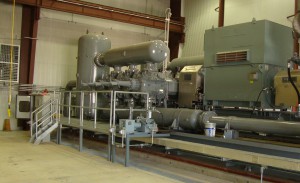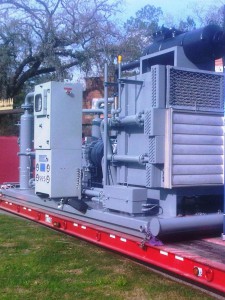September 2012, Vol. 239 No. 9
Features
Dual Drive Compressor Fills A Need By Cutting Emissions And Costs

There is a new age dawning in compression, according to Energy Transfer Technologies (ETT).
For decades, when natural gas pipeline companies went looking for compression services there were only two fuel choices to power the compressors: natural gas or electricity.
Each fuel option came with distinct advantages and disadvantages, which forced pipeline companies to make a compromise when it came to selecting compression. For example, natural gas-driven compressors currently run on a cheaper fuel source and do not require electrical power on site, but they produce more emissions leading to permitting issues. And, while electric-driven compressors produce little or no emissions, they are tied to the electrical grid, which means they lose power during outages, and — even more troubling — they have to shut down operations when electricity use is high or face costly demand fees.
Convinced there had to be a way to reduce emissions, lower costs and improve operating time, ETT says a group of some of the brightest minds in the energy industry came together in 2004 with the idea to build a compressor that offered the best of both electric- and natural gas-driven compression, and the idea of Dual Drive technology started to take shape.
Two Drivers On One Skid
ETT created the first-of-its kind compression system that has one compressor powered by two drivers, all on one skid.
This patented Dual Drive system is said to be one the most efficient in the marketplace in addition to offering ease of operation and maintenance. The Dual Drive provides an industry-leading 99% runtime by offering the ability to switch operations seamlessly between the electric and natural gas drivers depending on fuel cost, electricity demand, power outages, maintenance demands or emission restrictions.
“It was the perfect time to introduce the industry to Dual Drive compression,” says an ETT representative. “The Barnett Shale was just hitting its stride in North Texas, and there were a large number of counties with air quality issues, which made gas-driven compression difficult to install. Because of emission-permitting restrictions, many companies were forced to install electric compressors, but found that they were dependent on the electrical grid, which is tough to manage in Texas where summer temperatures regularly soar above 100 degrees F.
“Our Dual Drive system allowed these companies to decrease emissions and permit their sites for electrical compression, while still having the flexibility to switch to natural gas when extreme temperatures put a strain on the power grid and utilities charged steep demand fees, or during power outages.”
Soon the natural gas industry began to recognize the potential for the Dual Drive system. In 2009, ETT received the Innovative Technologies Award from the Texas Commission for Environmental Quality (TCEQ) for its emissions-reducing capabilities.
The most recent development in ETT’s Dual Drive system is the E-Select CA Series, which features an electric motor placed between a Caterpillar natural gas engine and an Ariel compressor linked by an overrunning clutch. These new compressor packages are available in horsepower options that range from 95-5,000 HP.
The Secret Ingredient
The key to the efficiency of the E-Select CA Series is the seamless transition between drivers that is made possible through the over-running clutch that connects the natural gas engine and electric motor to the compressor. Upon start-up, the natural gas engine brings the compressor to operating capacity. Once the system is running, the over-running clutch then allows the electric motor and the natural gas engine to switch the compression load back and forth as needed with virtually no interruption to gas flow. This is done by slowing down one driver while the other takes over.
“The efficient transition between drivers is what gives the E-Select CA Series an industry-leading 99% runtime,” said David Coker, president of ETT. “The switch takes less than 30 seconds and can be done remotely. So despite maintenance or power outages, the E-Select CA Series keeps operations running smoothly.”
Flexible Fuel Costs
Under current market conditions, it is more cost-efficient to operate a natural gas-driven compressor since natural gas prices have been running close to $2 per million BTU, cheaper than the equivalent amount of power through electricity. But this hasn’t always been the case. In 2008, natural gas was trading at an average of $8.90 per million BTU, making it cheaper to operate electric compressors.
“There is normally a price spread between natural gas and electricity, and the cost of these fuels is always fluctuating,” said Coker. “The E-Select CA Series eliminates the problem of not being able to take advantage of the spread because operators have the flexibility to run their compressors based on the cheapest fuel source.”
Significant Power Savings
One of the major economic benefits of the E-Select CA Series comes from the cost-reduction opportunities from electrical power providers. Because the compressor can quickly get off the electrical grid by switching the load to the natural gas engine, there are several opportunities to save millions with electricity providers throughout the country:
1. Side-Step Demand Fees. In Texas for example, the Electric Reliability Council of Texas (ERCOT) and several electrical co-ops throughout the state charge demand fees during the summer months to users who are tied to the electrical grid. These fees are set based on four coincident peak times (4CP) during the months of June through September when electric demand reaches its highest point.
The E-Select CA Series allows pipeline companies to completely avoid these demand fees by switching to the natural gas engine during these designated 4CP times, which usually occur between 4:30 p.m. to 5:00 p.m.
2. Incentives Through Demand Side Management. Several power companies throughout the nation have programs that provide incentives to companies that are able to decrease the load on the grid during peak times through demand-side management. The E-Select CA Series is perfectly designed to take advantage of these programs and allow pipeline companies to operate on the natural gas driver to ease the load on the power grid from the demand side in exchange for valuable financial incentives. Demand-side management is another reason why the Dual Drive system makes a significant economic difference.
3. Avoid Peak Pricing. In deregulated electricity markets, power prices often increase significantly during extreme heat or freezing cold temperatures. During these peak times, the E-Select Dual Drive system can quickly switch to the natural gas engine to take advantage of the lowest cost fuel source.
Expert Power Management
When a pipeline company purchases an E-Select CA Series, ETT also provides expertise in power management. ETT provides 24-hour monitoring of natural gas and electricity prices to alert customers when they would benefit financially by switching drivers. The ETT staff has experience in predicting peak demand times throughout the year and can guide customers to maximum cost-savings.
Gathering Speed
“This has been a breakout year for our Dual Drive compressors,” said Coker. “At the beginning of 2012, we had 48,000 HP of Dual Drive compressor systems in the field, and we have now confirmed orders of an additional 90,000 HP.
“Midstream companies realize they don’t have to compromise when it comes to compression, and we are excited to see how much the Dual Drive system will grow in the next few years,” added Coker. “ETT started in Texas, but we have our sights on bringing Dual Drive compression to booming oil and gas areas such as the Bakken Shale in North Dakota, the Marcellus Shale in Pennsylvania and West Virginia. We are also looking at opportunities in places like California, where the Dual Drive system can make a significant impact because of the very strict emission regulations.”
Natural Gas-Driven Compression
Advantages:
• Currently the lower cost fuel source
• Operates independently from the electrical grid
Disadvantages:
• Higher emissions
Electric-Driven Compression
Advantages:
• Lower emissions
Disadvantages:
• Shut down during power outages
• Costly electrical demand fees
E-Select CA Series
Advantages:
• Can always run on the lower cost fuel source
• Not dependent on the electrical grid
• Lower emissions
• Avoid costly demand fees
Under The Hood
The E-Select CA Series is available in horsepower options ranging from 95-5,000 HP, so it can serve small independent customers all the way to large-scale pipeline systems. ETT says it only uses the highest quality components in all of its Dual Drive systems, so let’s take a look under the hood:
E-Select CA Series 3616 (5000 HP)

Engine: Caterpillar 3616 TALE 4735 bhp
Motor: Hyundai Ideal 5,000 HP
Compressor Frame: Ariel JGD-6 Single stage with 11-inch cylinders
Cooler: Air-X-Changer Z style
Clutch: SSS Over-running Clutch
Couplings: Voith Hydraulic
Controls: Allen-Bradley Controllogix L32 PLC with Panel View Plus MMI
Motor Starters: Allen-Bradley
Current Conditions:
• Suction: 660 psig
• Discharge: 1,020 psig
• Volume: 185 MMcf/d
E-Select CA Series 3606 (1750 HP)

Engine: Caterpillar 3606 TALE 1,775 bhp
Motor: Teco-Westinghouse 1,750 hp
Compressor Frame: Ariel JGD-4 Two stage with 12.5 inch and 7.875 inch cylinders
Cooler: Air-X-Changer EH style
Clutch: SSS Over-running clutch
Couplings: Voith Hydraulic
Controls: Allen Bradley Controllogix L32 PLC with Panel View Plus MMI
Motor Starters: Allen-Bradley
Current Conditions:
• Suction: 215 psig
• Discharge: 740 psig
• Volume: 27 MMcf/d
E-Select CA Series 3304 (100 HP)

Engine: Caterpillar G 3404 NA 95 bhp
Motor: Baldor 100 HP
Compressor Frame: Ariel JGP-2 Three stage with 5.5-inch, 4.375-inch and 2.75-inch cylinders
Cooler: Air-X-Changer EH style
Clutch: SSS Over-running Clutch
Couplings: Voith Hydraulic
Controls: Altronic
(end of sidebar)





Comments